As spring tiptoes around the corner, warmer days are on the horizon. Trees rejoice by leafing out into lush, green canopies. But they’re not the only ones celebrating the return of spring. Insects and bugs galore are also waiting to pop out their little heads and take advantage of the warmer weather and growing trees. Now is the time to gear up against all the bugs and pests that threaten our trees. In the following blog, we’ll dive into the top six tree pests and cover tips on their identification, prevention, and treatments.
Types of Insects that Kill Trees and Shrubs
Before we jump into the specifics of our six tree-killing culprits, let’s go over the major insect pest groups that pose a threat to our trees. In the grand scheme of nature, not all insects are enemies. Many insects are actually good bugs, playing beneficial roles in pollinating flowers or preying on the bad bugs. However, the small percentage of bad bugs can wreak havoc on trees by feeding upon leaves, branches, and trunks. An easy way to remember and understand these pests is by their feeding habits: piercing-sucking, chewing, and boring.
Piercing-sucking insects, like aphids and scale insects, extract plant juices by piercing the tree’s vascular system. Chewing insects, such as caterpillars, devour leaves, sometimes stripping the whole canopy. Boring insects, like the bronze birch borer, bore or tunnel into the tree’s branches and trunk, causing extensive damage to tree health and structure.
Now, let’s shine a spotlight on our six notorious tree-killing pests. We’ll examine their identification, symptoms of damage, prevention strategies, and effective treatment options.
#1 Emerald Ash Borer
Identification: The emerald ash borer is a metallic green beetle with a distinct bullet-shaped body, measuring around half an inch in length.
Symptoms of Damage: Keep an eye out for dieback in the upper canopy, D-shaped exit holes on the bark, and S-shaped larval galleries under the bark.
Prevention: Implement early detection measures through regular monitoring and preventative treatments.
Treatment: Apply trunk injections of emamectin benzoate, preferably in mid to late spring before adult flight. Promptly remove and destroy highly infested trees that are beyond saving.
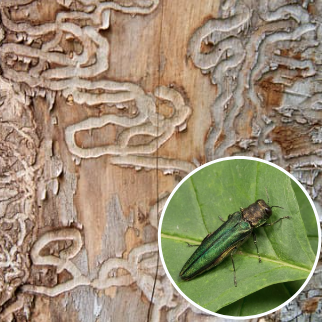
#2 Asian Longhorned Beetle
Identification: Look for large, black beetles with long antennae and distinctive white spots.
Symptoms of Damage: Keep an eye out for round exit holes, sawdust-like frass (sawdust and insect droppings) around the base of the tree, and oozing sap.
Prevention: Enforce strict regulations on firewood movement and encourage removal of heavily infested trees.
Treatment: Infested trees must be promptly removed and destroyed. Trunk injections of emamectin benzoate could save trees with lower degrees of infestation.
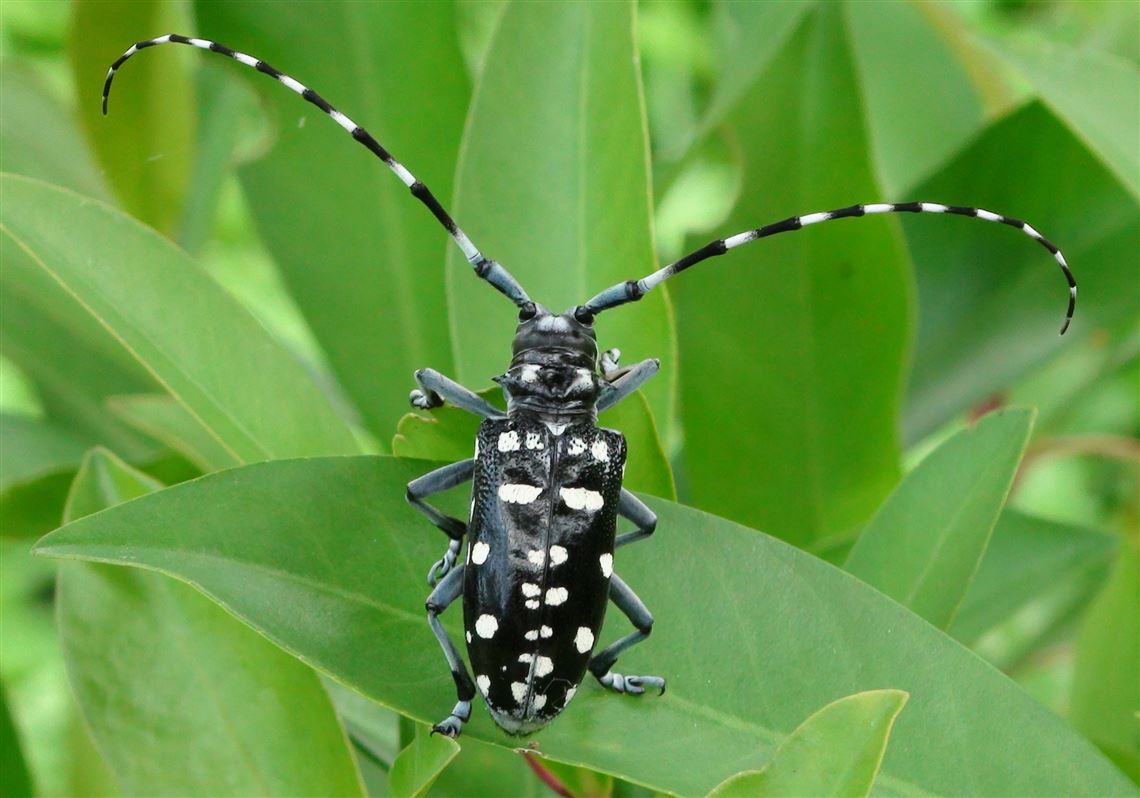
#3 Gypsy Moths
Identification: Male moths are brown and equipped with feathery antennae, while females are larger and have a white hue.
Symptoms of Damage: Watch for defoliation, egg masses on tree trunks, and silk threads hanging from branches.
Prevention: Use pheromone traps and introduce natural predators when possible.
Treatment: Apply a trunk injection or soil injection of acephate in spring before pest emergence. Another option is the manual removal of egg masses.

#4 Aphids
Identification: Look for tiny, pear-shaped insects in an array of green, blue, or yellow colors, often forming colonies on leaves and stems.
Symptoms of Damage: Keep an eye out for curled or yellowing leaves, sticky honeydew residue, and the growth of sooty mold.
Prevention: Keep a vigilant eye through regular monitoring and introduce beneficial insects if possible.
Treatment: Apply insecticidal soap or a high-pressure water spray to knock off aphids. Chemical treatments include soil injection of imidacloprid, bark spray of dinotefuran, and trunk injection of acephate, best applied in late winter through spring.
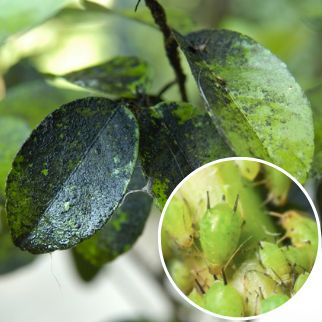
#5 Forest and Eastern Tent Caterpillars
Identification: These hairy caterpillars are easily recognized by the distinctive tent-like webs they construct to feed and hide under.
Symptoms of Damage: Look for defoliation, the presence of silk tents, and weakened branches.
Prevention: Prune off and destroy egg masses and tents.
Treatment: Apply a trunk injection or soil injection of acephate in spring before pest emergence.
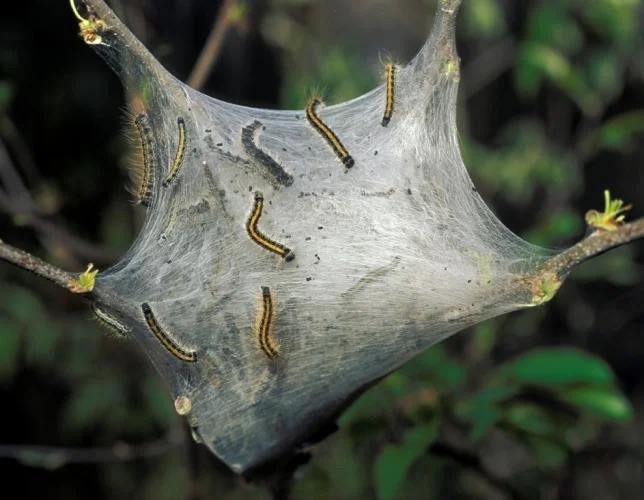
#6 Scale Insects
Identification: Look for small, oval-shaped insects shielded by a protective covering. The covering is often waxy, fluffy, or cottony.
Symptoms of Damage: Watch for yellowing or curling leaves, sticky honeydew residue, and the growth of sooty mold fungus.
Prevention: Regularly inspect trees, practice proper pruning, and encourage the presence of natural predators.
Treatment: Apply insecticidal soap or horticultural oils. Chemical treatments include soil injection of imidacloprid, bark spray of dinotefuran, and trunk injection of acephate, best applied in late winter through spring.
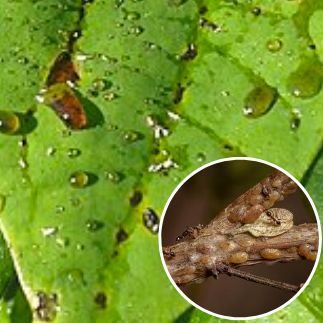
How do I Keep Insects from Killing My Trees?
Now that we’ve discussed the details of these insect pests, let’s talk about how to stop them from defeating your trees. The best thing to do is to prevent pests from attacking in the first place. Regularly inspect your trees so you can act early if there are any problems. Maintain optimal soil and root health by applying mulch, soil amendments, and fertilizers as needed. Use proper watering and pruning practices to keep your trees healthy. All these steps make a significant difference because a healthy tree is less prone to pest infestations. And even if infested, a healthy tree is better able to defend itself, fight off the pest, and recover!
Once your trees start showing signs of insect damage and stress, apply the necessary treatments and ensure that the tree is cared for properly. Got questions? Our arborists are here with pest management services to care for you and your trees. Simply reach out for an assessment!





